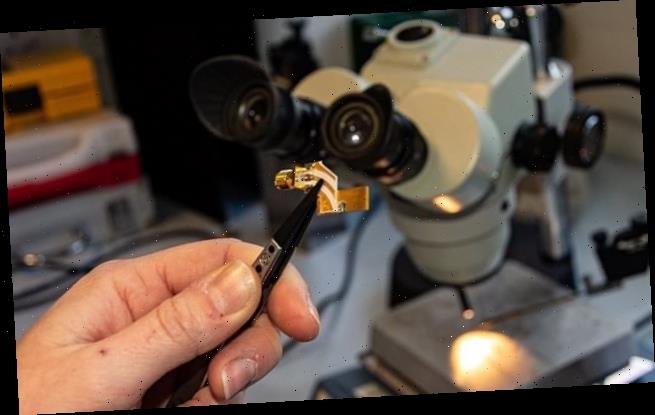Superfast internet breakthrough: Scientists use lasers to transmit data at 100 gigabits per second – 1,000 times quicker than Ethernet
- British scientists used pulses of light in the terahertz range of light waves
- They used sound waves to send around 100 billion light pulses a second
- ‘Terahertz quantum cascade lasers’ could provide masses of data at high speeds
Scientists have used special lasers to generate an ultra-fast transfer of data at 100 gigabits per second – one thousand times quicker than a fast Ethernet cable.
British scientists found a way to control ‘terahertz quantum cascade lasers’, which emit light in the terahertz range of the electromagnetic spectrum.
The lasers could provide ultra-fast wireless links where large quantities of data are transferred across hospital campuses or universities.
Terahertz radiation occupies a space between microwaves and infrared light waves known as the ‘terahertz gap’.
The problem with using light in the terahertz gap is that the lasers need to be modulated very rapidly – switching on and off or pulsing around 100 billion times every second.
Pictured, the terahertz quantum cascade laser on its mounting apparatus. A pair of tweezers is also shown for scale
Engineers at the University of Leeds and the University of Nottingham believe they have now found of way of achieving this – by combining light with the power of sound waves.
WHAT ARE TERAHERTZ QUANTUM-CASCADE LASERS?
Terahertz quantum-cascade lasers (TQCLs) can radiation in the terahertz range of the electromagnetic spectrum.
TQCLs deliver high-resolution imaging than microwaves and provides higher contrast images than x-rays.
They have applications in communications, homeland security screening, biomedicine, and quality control.
The terahertz range refers to electromagnetic waves with wavelengths between 3 mm and 30 μm.
The terahertz range has light with longer waves than that of visible light –the light that humans can see.
‘This is exciting research,’ said Professor John Cunningham, of Leeds University.
‘At the moment, the system for modulating a quantum cascade laser is electrically driven – but that system has limitations.
‘Ironically, the same electronics that delivers the modulation usually puts a brake on the speed of the modulation.
‘The mechanism we are developing relies instead on acoustic waves.’
As an electron passes through the optical component of the quantum cascade laser, it goes through a series of ‘quantum wells’ where the energy level of the electron drops and a photon – a pulse of light energy – is emitted.
One electron is capable of emitting multiple photons, and this is the process that is controlled during the modulation.
Instead of using external electronics, the researchers used acoustic waves to vibrate the quantum wells inside the quantum cascade laser, generated by the impact of a pulse from another laser onto an aluminium film.
This caused the film to expand and contract, sending a mechanical wave through the quantum cascade laser.
‘Essentially, what we did was use the acoustic wave to shake the intricate electronic states inside the quantum cascade laser,’ said Tony Kent, Professor of Physics at the University of Nottingham.
‘We could then see that its terahertz light output was being altered by the acoustic wave.
The terahertz range refers to electromagnetic waves with frequencies between 100 GHz and 10 THz, or wavelengths between 3 mm and 30 μm, shorter than infra-red but longer than microwaves
‘This result opens a new area for physics and engineering to come together in the exploration of the interaction of terahertz sound and light waves, which could have real technological applications,’ Professor Kent said.
While the research team could not yet stop and start the flow completely, they were able to control the light output by a few per cent – which is a ‘great start’, Professor Cunningham said.
‘We believe that with further refinement, we will be able to develop a new mechanism for complete control of the photon emissions from the laser, and perhaps even integrate structures generating sound with the terahertz laser, so that no external sound source is needed.’
The findings were published in the journal Nature Communications.
Source: Read Full Article


